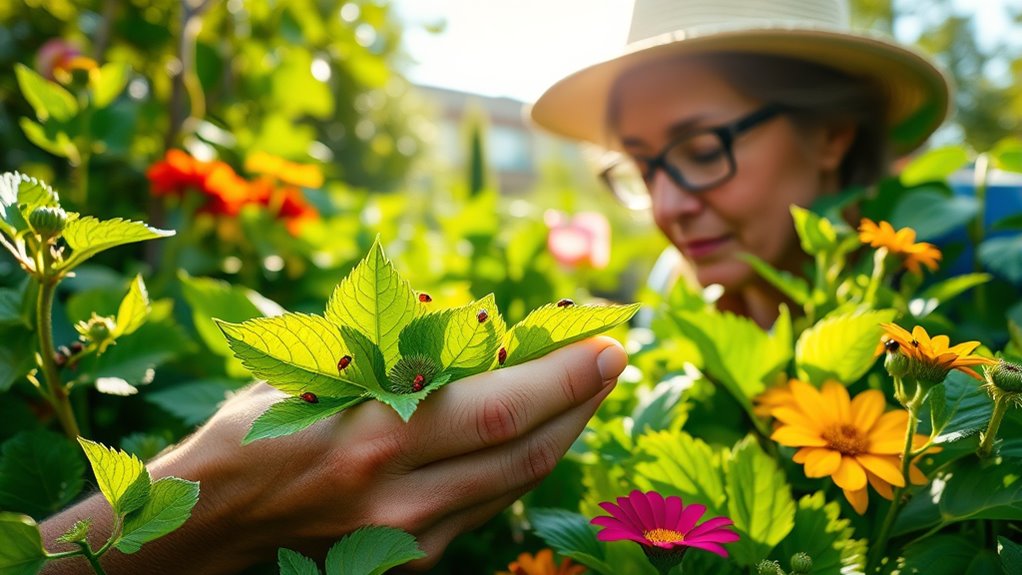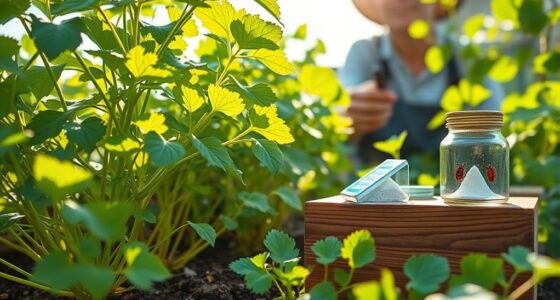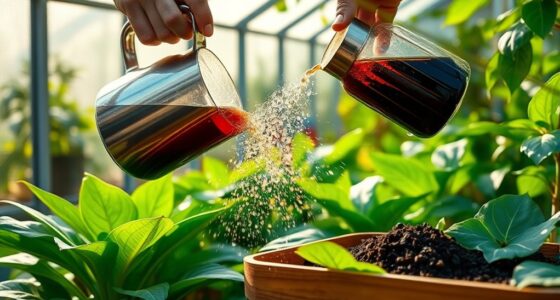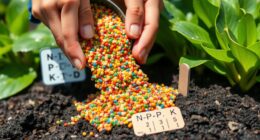Integrated Pest Management (IPM) is a sustainable approach that combines regular pest monitoring, encouraging natural enemies like beneficial insects, and using targeted treatments when necessary. It focuses on preventing pests early and minimizing chemical use to protect your plants, beneficial insects, and the environment. By understanding pest behavior and applying this integrated strategy, you can keep your garden healthy and productive. Stay with us to uncover more tips on mastering IPM effectively.
Key Takeaways
- IPM combines pest monitoring, biological controls, and targeted interventions to manage pests sustainably.
- It emphasizes early detection and understanding pest behavior to prevent severe infestations.
- Uses natural enemies like beneficial insects to control pests, reducing reliance on chemical pesticides.
- Promotes environmentally friendly practices that protect beneficial insects, plants, and ecosystems.
- Aims for effective pest control while minimizing chemical use and supporting garden health.
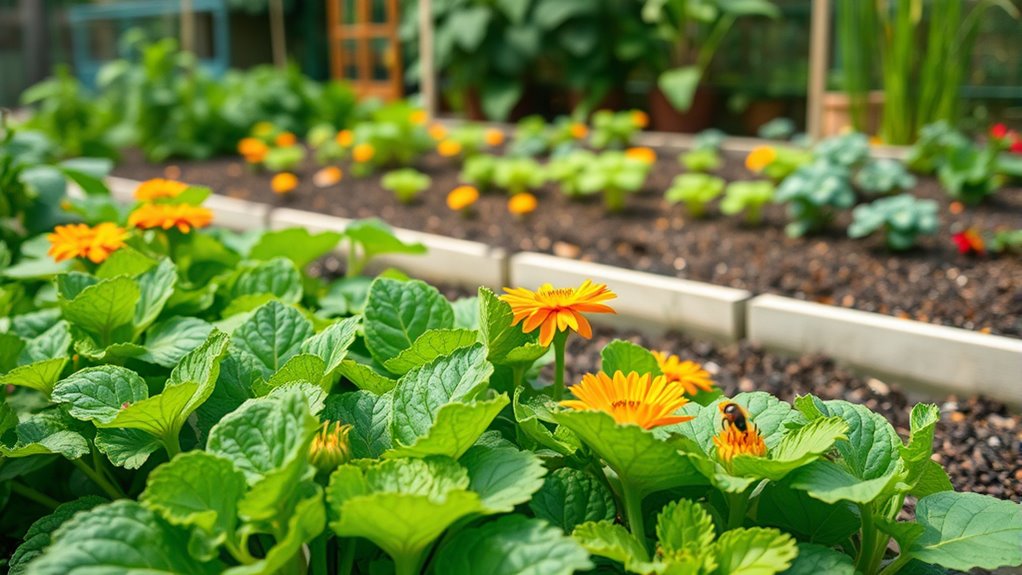
Have you ever wondered how to keep pests under control without harming your garden or the environment? That’s where integrated pest management, or IPM, comes into play. IPM is a smart, sustainable approach to managing pests that combines different strategies to reduce reliance on chemical pesticides. It emphasizes understanding pest behavior, monitoring their presence, and using targeted methods to keep their populations in check. This way, you protect your plants, beneficial insects, and the broader ecosystem while maintaining a healthy garden.
A key component of IPM is pest monitoring. This involves regularly inspecting your plants for signs of pests or damage. By keeping an eye on pest activity, you can catch problems early, before they become severe. Pest monitoring helps you decide when intervention is necessary and guides you toward the most effective control methods. For example, if you notice a few aphids on your tomatoes, you might act quickly to remove them before they spread and cause extensive damage. Monitoring also helps you assess the effectiveness of your control measures, so you can adapt your approach if needed.
Biological controls are another essential part of IPM. These involve using natural enemies of pests to keep their populations in balance. For instance, beneficial insects like ladybugs, lacewings, or parasitic wasps prey on common pests such as aphids, mites, or caterpillars. Introducing or encouraging these natural predators in your garden can considerably reduce pest numbers without the use of chemicals. It’s a sustainable way to manage pests and supports a healthy, diverse garden ecosystem. To maximize biological controls, you should create a welcoming environment for these beneficial insects by planting diverse, nectar-rich flowers and avoiding broad-spectrum insecticides that can harm them.
Integrating pest monitoring and biological controls offers a proactive approach. By regularly checking your plants and fostering natural enemies, you can prevent pest outbreaks and minimize chemical use. When pests do appear, you can employ targeted interventions like applying organic insecticides or physically removing pests, rather than blanket spraying your entire garden. This integrated approach not only safeguards your plants but also promotes beneficial insects and the overall health of your garden environment.
In essence, IPM is about being attentive, strategic, and environmentally responsible. It’s a way to protect your garden’s productivity and beauty while reducing the negative impacts associated with conventional pest control methods. With pest monitoring, biological controls, and other integrated strategies, you gain better control over pests and cultivate a thriving, sustainable garden. Additionally, understanding proper identification of pests ensures that you use the most effective and environmentally friendly control methods, minimizing unnecessary interventions.
Frequently Asked Questions
How Does IPM Compare to Traditional Pest Control Methods?
Compared to traditional pest control methods, IPM uses sustainable approaches that focus on pest monitoring and targeted actions. You actively assess pest levels and only intervene when necessary, reducing chemical use. This method minimizes environmental impact and promotes healthier gardens. Unlike conventional sprays that may harm beneficial insects, IPM emphasizes prevention, biological controls, and monitoring, making it a smarter, eco-friendly choice for managing pests effectively.
Are There Any Environmental Risks Associated With IPM?
Think of IPM as a careful gardener tending a delicate ecosystem. While it minimizes chemical runoff and reduces non-target effects, some risks remain if not properly managed. You might worry about unintended harm to beneficial insects or water contamination. However, by focusing on targeted, environmentally conscious practices, you help protect your garden and the surrounding environment, ensuring that pest control doesn’t become a double-edged sword.
Can IPM Be Used for Organic Gardening Practices?
Yes, you can definitely use IPM with organic methods and natural solutions. It’s a flexible approach that emphasizes prevention and minimal chemical use, aligning well with organic gardening principles. You’ll focus on healthy soil, beneficial insects, and organic treatments, reducing pests effectively without synthetic pesticides. This way, you protect your garden’s ecosystem while maintaining organic standards, making IPM a sustainable and eco-friendly pest management strategy.
What Are the Common Tools Used in IPM?
Imagine battling pests with a toolbox of smart solutions. You’ll use biological controls like beneficial insects to naturally reduce pests, paired with mechanical tools such as traps, barriers, and hand-picking. These tools work together, minimizing chemical use and protecting your garden’s health. By combining biological controls with mechanical methods, you create a balanced approach that’s effective, eco-friendly, and tailored to your garden’s unique needs.
How Long Does It Typically Take to See Results With IPM?
Timing expectations for seeing observable effects with IPM vary based on your garden’s conditions and pest issues. Usually, you might notice improvements within a few weeks if you consistently follow your integrated approach. Some pests may take longer to control, especially if populations are high. Patience is key, and regular monitoring helps you adjust tactics, ensuring your efforts lead to a healthier, pest-resilient garden over time.
Conclusion
By adopting integrated pest management, you’re like a skilled gardener tending a delicate balance. You’ll control pests effectively while protecting your plants and the environment. It’s a smart, sustainable approach that’s as natural as a gentle breeze guiding your garden’s health. With patience and vigilance, you’ll create a thriving, pest-resistant garden, where harmony blooms like a beautiful melody. Embrace IPM, and watch your garden flourish with resilience and beauty.
